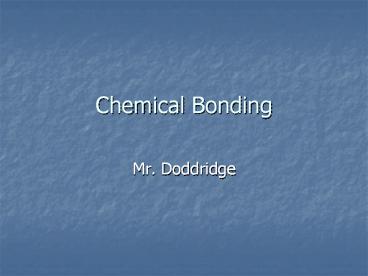Chemical Bonding - PowerPoint PPT Presentation
Title:
Chemical Bonding
Description:
Chemical Bonding Mr. Doddridge Formal Charge The formal charge of any atom in a molecule is the charge the atom would have if all the atoms in the molecule had the ... – PowerPoint PPT presentation
Number of Views:119
Avg rating:3.0/5.0
Title: Chemical Bonding
1
Chemical Bonding
- Mr. Doddridge
2
Formal Charge
- The formal charge of any atom in a molecule is
the charge the atom would have if all the atoms
in the molecule had the same
electronegativity.
3
Formal Charge
- Rules
- All unshared (nonbonding) electrons are assigned
to the atom on which they are found. - For any bond single, double, or triple half
of the bonding electrons are assigned to each
atom in the bond. - The Formal Charge of each atom is calculated by
subtracting the number of electrons assigned to
the atom from the number of valence electrons in
the isolated atom.
4
Formal Charge
2
½(2)
5
Formal Charge
2
6
Formal Charge
2
- Total electrons assigned to the first oxygen atom
is 7. - How about the other two atoms?
- 4 and 5 respectively.
- How do these charges compare to the expected
charges? - Since carbon is usually four, its formal charge
in this configuration is 0 (net change). - What are the formal charges of the two oxygens?
- Normal charge for oxygen is 6 therefore the
formal charge of the first oxygen is -1 and the
second oxygen is? - 1. (Note the net charge of the molecule.)
- But is this the only possible arrangements of the
electrons? - What about?
7
Formal Charge
O
O
C
- What are the formal charges on each atom?
- 0, 0, 0
- 22½(4)6 6 0
8
Resonance Structures
O
O
C
- Since both structures are possible they are
called resonance structures. - In Fact
- Which structure is most likely?
9
Molecular GeometriesHybridized OrbitalsMultiple
Bonds
10
These can hybridize to form
11
- The truth is the one s and two p orbitals
have hybridized into sp orbitals in fact sp2.
- What shape can this molecule have? (Remember,
this is simply the central atom).
12
- How many p-orbitals are there?
- What is the maximum sp hybridization?
- What would it look like?
13
- Notice the angle between all three hybridized
orbitals will be the same? - 109.5
14
Some Definitions
- Bonds formed from the overlap of orbitals in the
plane between two atoms are called sigma (s)
bonds. - Bonds formed from the overlap of unhybridized p
orbitals (above and below the central plane) are
called pi (p) bonds.
15
- In this atom we have three sp2 orbitals and one
unhybridized p orbital. - The unhybridized p orbital is available to make a
p bond outside the center plane of the s bond.
16
Sigma bond
- On the center plane
17
Pi bond
- Starts out looking like this and then the
unhybridized p orbitals overlap.
18
Pi bond
19
Pi bond
- This is one pi bond in the y plane.
- This results in one double bond.
20
Molecular Geometries
or
21
(No Transcript)
22
H2O
O
H
H
23
H2O
and
or
O
H
H
24
The End































